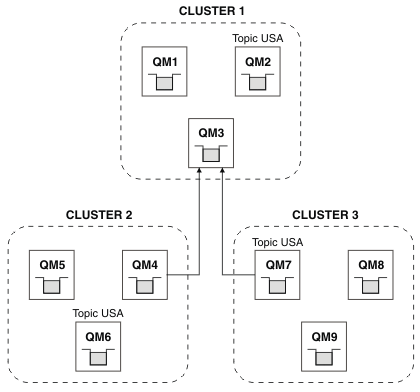Combining the topic spaces of multiple clusters
Create topic spaces that span multiple clusters. Publish to a topic in one cluster and subscribe to it in another.
Before you begin
This task assumes that we have existing direct routed publish/subscribe clusters, and you want to propagate some cluster topics into all the clusters. Note: We cannot do this for topic host routed publish/subscribe clusters.
To propagate publications from one cluster to another, you need to join the clusters together in a hierarchy; see Figure 1. The hierarchical connections propagate subscriptions and publications between the connected queue managers, and the clusters propagate cluster topics within each cluster, but not between clusters.
The combination of these two mechanisms propagates cluster topics between all the clusters. You need to repeat the cluster topic definitions in each cluster.

The following steps connect the clusters into a hierarchy.
Procedure
- Create two sets of sender-receiver channels to connect QM3 and QM4, and QM3 and QM7, in both directions. You must use traditional sender-receiver channels and transmission queues, rather than a cluster, to connect a hierarchy.
- Create three transmission queues with the names of the target queue managers. Use queue manager aliases if we cannot use the name of the target queue manager as the transmission queue name for some reason.
- Configure the transmission queues to trigger the sender channels.
- Check the PSMODE of QM3, QM4 and QM7 is set to ENABLE.
- Alter the PARENT attribute of QM4 and QM7 to QM3.
- Check the status of the parent-child relationship between the queue managers is active in both directions.
- Create the administrative topic USA with the attribute CLUSTER ( 'CLUSTER 1' ), CLUSTER ( 'CLUSTER 2' ), and CLUSTER ( 'CLUSTER 3' ) on each of the three cluster topic host queue managers in clusters 1, 2 and 3. The cluster topic host does not need to be a hierarchically connected queue manager.
What to do next
We can now publish or subscribe to the cluster topic USA in Figure 1. The publications subscriptions flow to publishers and subscribers in all three clusters.Suppose that you did not create USA as a cluster topic in the other clusters. If USA is only defined on QM7, then publications and subscriptions to USA are exchanged between QM7, QM8, QM9, and QM3. Publishers and subscribers running on QM7, QM8, QM9 inherit the attributes of the administrative topic USA. Publishers and subscribers on QM3 inherit the attributes of SYSTEM.BASE.TOPIC on QM3.
See also Combining and isolating topic spaces in multiple clusters.